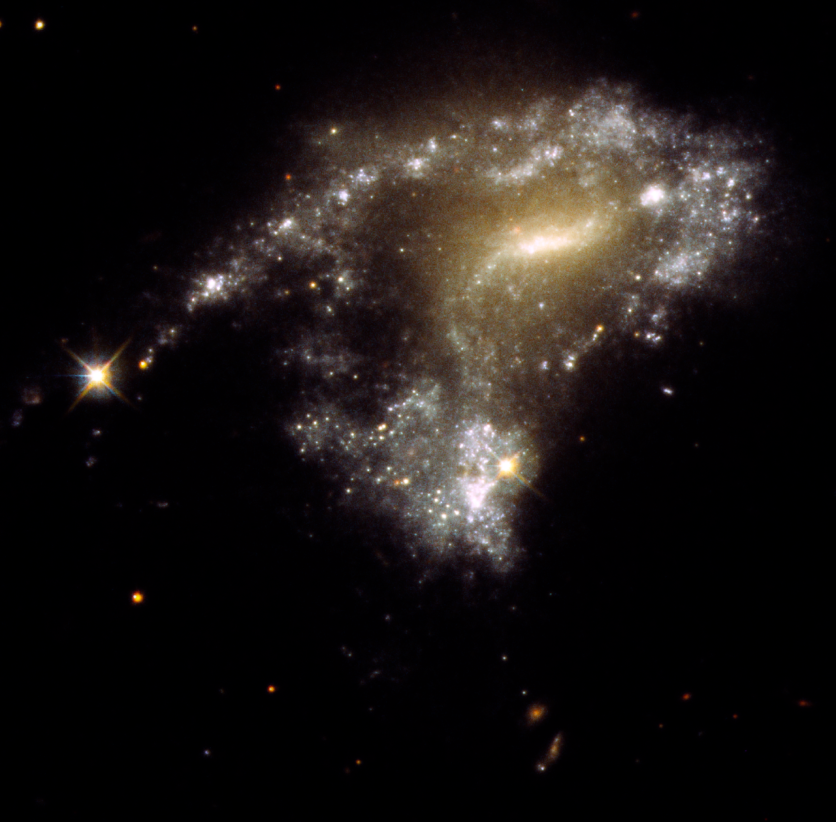Shine bright like a pearl!
NASA's Hubble Space Telescope has encountered a shimmering celestial spectacle as it peers into the depths of the universe, uncovering a phenomenon dubbed the "string of pearls" in a galactic collision.

12 Interacting Galaxies
In the vast expanse of space, Galaxy AM 1054-325 has undergone a remarkable transformation, morphing from its traditional spiral shape into a mesmerizing S-shape under the gravitational influence of a neighboring galaxy.
This cosmic dance has stretched out the galaxy's form, giving rise to what appears to be a string of luminous pearls, each representing a cluster of newborn stars.
NASA explains that these galactic encounters do not spell doom for the stars within. Instead, they serve as catalysts for the birth of new stellar generations and, potentially, their accompanying planets.
Delving into this cosmic phenomenon, NASA's Hubble Space Telescope has turned its gaze toward 12 interacting galaxies, revealing long, tadpole-like tails composed of gas, dust, and myriad stars.
With its unparalleled precision and sensitivity to ultraviolet light, Hubble has unveiled a stunning sight - 425 clusters of newly formed stars dotting these tails like strings of festive lights, each boasting up to a million youthful, blue-hued stars.
Star Clusters in Tidal Tails
NASA notes that star clusters within tidal tails have been known for some time, observed in iconic examples such as the Antennae and Mice galaxies, adorned with elongated projections resembling fingers.
Astronomers, leveraging a blend of fresh observations and archival data, have delved into the ages and masses of these star clusters within tidal tails, discovering their youthful nature - a mere 10 million years old. Furthermore, these clusters seem to be emerging consistently along tails stretching across thousands of light-years.
Lead author Michael Rodruck of Randolph-Macon College in Ashland, Virginia, expressed surprise at the abundance of young objects within the tails, shedding light on the efficiency of cluster formation in such environments.
The gravitational interplay between interacting galaxies effectively extends a galaxy's spiral arm into space, shaping the elongated tails observed by Hubble.
Prior to these galactic mergers, molecular hydrogen clouds within the galaxies may have lain dormant. However, the turbulent encounters stirred these clouds, triggering a frenzy of star formation as the compressed hydrogen ignited the birth of stars, according to NASA.
Read Also : NASA Hubble Discovers Saturn's Ring System Heats Planet's Atmosphere-A Never-Before-Seen Phenomenon!
"String-of-Pearls"
The destiny of these stellar ensembles remains uncertain. They may persist as gravitationally bound entities, evolving into globular star clusters akin to those orbiting the outskirts of our Milky Way galaxy.
Alternatively, they may disperse, scattering to form a halo of stars surrounding their host galaxy or embarking on journeys as intergalactic wanderers.
This "string-of-pearls" phenomenon hints at a bygone era in the universe's history when galactic collisions were more prevalent. The galaxies observed by Hubble serve as windows into the distant past, offering insights into the cosmic ballet that unfolded in the early universe.
Related Article : NASA's Hubble Space Telescope Captures 'Butterfly Nebula' In Stunning Motion | Fun Facts About This Beautiful Space Butterfly

ⓒ 2025 TECHTIMES.com All rights reserved. Do not reproduce without permission.




